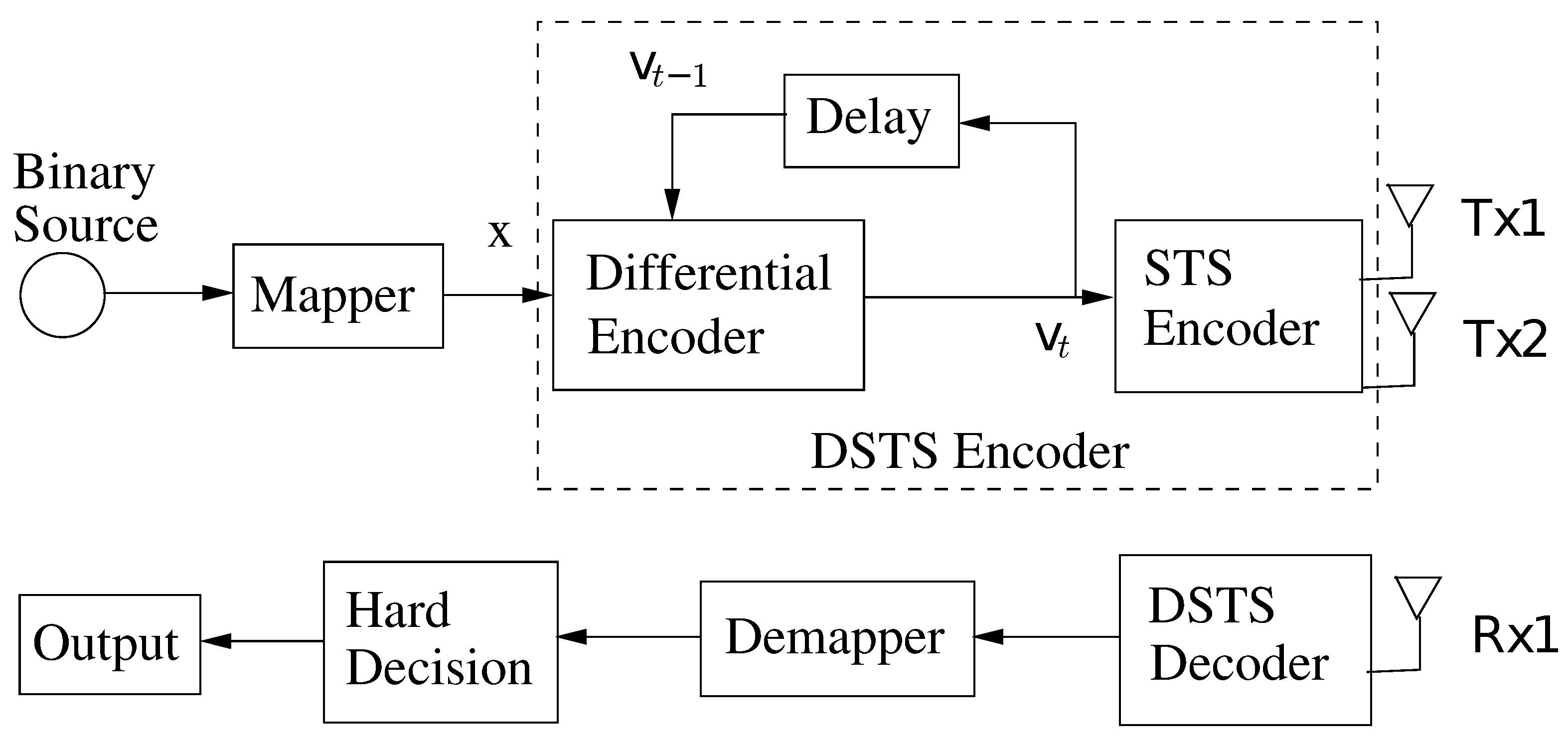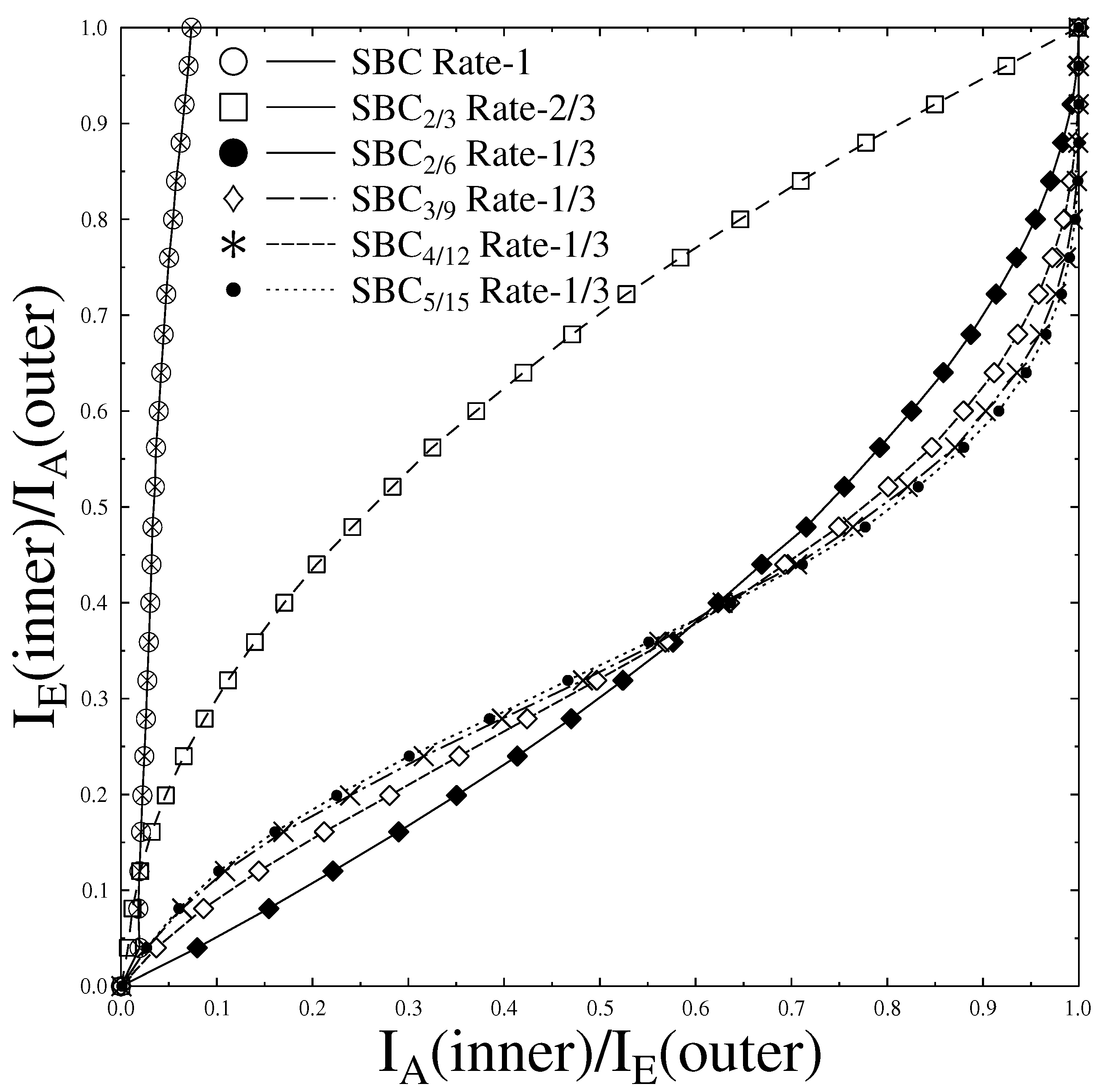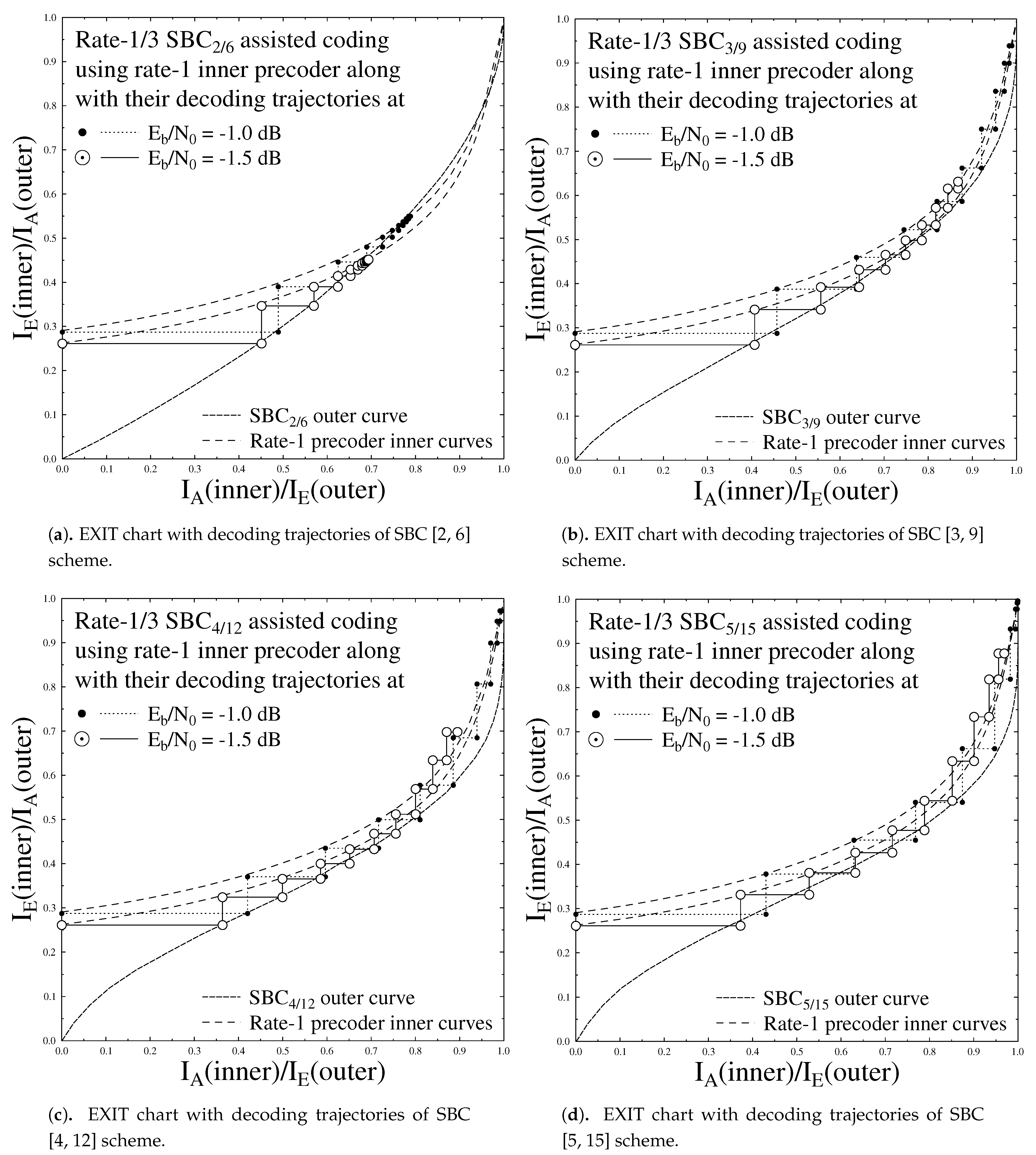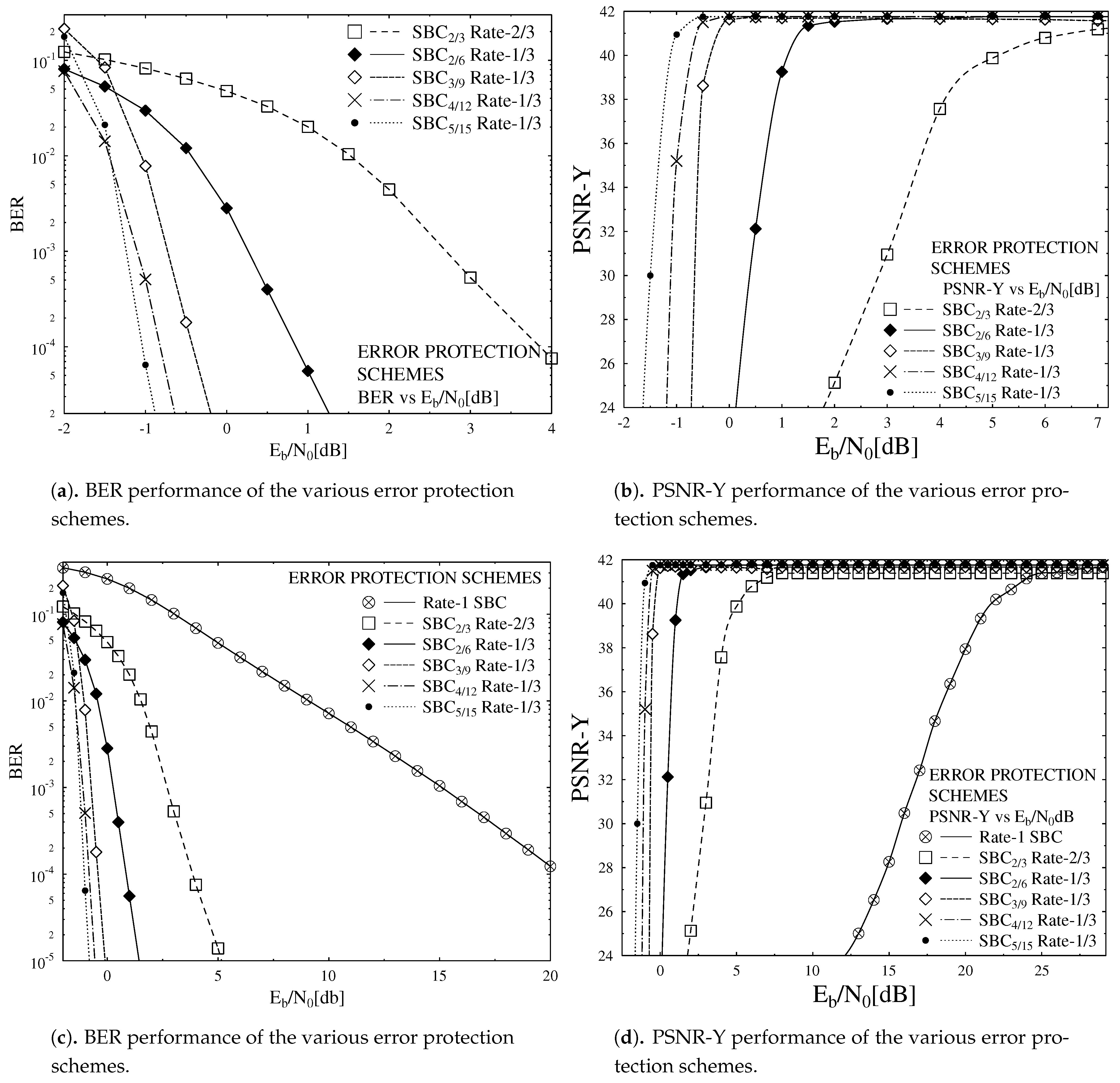Performance Analysis of Sphere Packed Aided Differential Space-Time Spreading with Iterative Source-Channel Detection
Abstract
1. Introduction
2. Related Contemporary Work
3. Source Coding Scheme (H.264/AVC)
4. Transmission Medium Schemes
- MIMO: Data sent over the wireless communication networks is prone to attenuation and experience losses during the transmission. Different techniques and settings of the wireless channel units are adopted to overcome these losses. The transmission medium used in this research is that of the Multiple-Input Multiple-Output (MIMO) system. This MIMO system comprises of multiple antennas for sending of multiple copies of the signal from the source side to cope with this attenuation and signal losses. Hence, some of the signals may experience less attenuation as compared to the others. This gives our system the required spatial diversity for improved wireless transmission.
- DSTS: The Space-Time Spreading (STS) is a technique used to overcome the shortfalls of the wireless channel such as fading of the signals. This technique is used to achieve a higher diversity gain as well as power gain from the transmit signal in multi-user MIMO systems. The advantage of DSTS is that it substantially decreases the complexity of the MIMO channel by eliminating the cumbersome task of channel estimation by employing non-coherent detection method. It provides diversity to wireless channel by employing both spatial and temporal domain coding. This introduces correlation between the signals transmitted in the same time slots. The benefit of space-time coding is that it gives diversity and power gain to the transmitted signal without a need for expansion of the bandwidth with a decreased complexity.
- SP Modulation: The novelty of this research is the use of SP and orthogonal codes in combination. The use of SP helps in achieving the maximum possible intra-symbol Euclidean distance while keeping the complexity low. The advantage of the combination of SP to DSTS is seen in the form of decreased complexity at the channel level by removing the channel estimation from our system. The reason behind this advantage is the reliance of our proposed system on non-coherent detection of our MIMO system. Furthermore, our proposed system decreases the complexity and cost of the receiver substantially, meanwhile increasing the error resilience. Equation (4) shows a generic two antenna design on the said principles:
5. Iterative Source-Channel Decoding
5.1. Overview of Proposed System
5.2. The Soft-Bit Source Decoding
6. Source Bit Code Based Iterative Source Channel Decoding
6.1. Iterative Convergence Criterion
6.2. Source Bit Codes Algorithm
6.3. Example of Proposed System
7. EXIT Chart Analysis
8. System Performance and Results
9. Conclusions
Author Contributions
Funding
Institutional Review Board Statement
Informed Consent Statement
Data Availability Statement
Acknowledgments
Conflicts of Interest
Abbreviations
| SBC | Source Bit Coding |
| JSCC | Joint Source Channel Coding |
| BER | Bit Error Ratio |
| ISCD | Iterative Source-Channel Decoding |
| LDPC | Low Density Parity Check |
| CSI | Channel State Information |
| MIMO | Multiple Input Multiple Output |
| SP | Sphere Packing |
| DP | Data Partitioning |
| DSTS | Differential Space Time Spreading |
| EXIT | Extrinsic Information Transfer |
| PSNR | Peak Signal to Noise Ratio |
| RSC | Recursive Systematic Convolutional |
| DP | Data Partitioning |
References
- Shafi, M.; Molisch, A.F.; Smith, P.J.; Haustein, T.; Zhu, P.; De Silva, P.; Tufvesson, F.; Benjebbour, A.; Wunder, G. 5G: A Tutorial Overview of Standards, Trials, Challenges, Deployment, and Practice. IEEE J. Sel. Areas Commun. 2017, 35, 1201–1221. [Google Scholar] [CrossRef]
- Cox, D.C. Fundamental limitations on increasing data rate in wireless systems. IEEE Commun. Mag. 2008, 46, 16–17. [Google Scholar] [CrossRef]
- Cisco, U. Cisco Annual Internet Report (2018–2023) White Paper. 2020. Available online: https://www.cisco.com/c/en/us/solutions/collateral/executive-perspectives/annual-internet-report/whitepaper-c11-741490.html (accessed on 26 March 2021).
- Nightingale, J.; Salva-Garcia, P.; Calero, J.M.A.; Wang, Q. 5G-QoE: QoE modelling for ultra-HD video streaming in 5G networks. IEEE Trans. Broadcast. 2018, 64, 621–634. [Google Scholar] [CrossRef]
- Cavdar, C.; Gera, D.; Hofmann, S.; Schupke, D.; Ghosh, A.; Nordlöw, A. Demonstration of an integrated 5G network in an aircraft cabin environment. In Proceedings of the 2018 IEEE/AIAA 37th Digital Avionics Systems Conference (DASC), London, UK, 23–27 September 2018; pp. 1–10. [Google Scholar]
- Streit, J.; Hanzo, L. Dual-mode vector-quantized low-rate cordless videophone systems for indoors and outdoors applications. IEEE Trans. Veh. Technol. 1997, 46, 340–357. [Google Scholar] [CrossRef]
- Hanzo, L.; Cherriman, P.; Kuan, E.L. Interactive cellular and cordless video telephony: State-of-the-art system design principles and expected performance. Proc. IEEE 2000, 88, 1388–1413. [Google Scholar] [CrossRef]
- Hanzo, L.; Cherriman, P.; Streit, J. Video Compression and Communications: From Basics to H.261, H.263, H.264, MPEG4 for DVB and HSDPA-Style Adaptive Turbo-Transceivers; John Wiley & Sons: New York, NY, USA, 2007. [Google Scholar]
- Hanzo, L.; Somerville, F.C.A.; Woodard, J. Voice and Audio Compression for Wireless Communications; John Wiley & Sons: New York, NY, USA, 2008. [Google Scholar]
- Richardson, I.E. H.264 and MPEG-4 Video Compression: Video Coding for Next-Generation Multimedia; John Wiley & Sons: New York, NY, USA, 2004. [Google Scholar]
- Maunder, R.G.; Wang, J.; Ng, S.X.; Yang, L.L.; Hanzo, L. On the performance and complexity of irregular variable length codes for near-capacity joint source and channel coding. IEEE Trans. Wirel. Commun. 2008, 7, 1338–1347. [Google Scholar] [CrossRef]
- Guyader, A.; Fabre, E.; Guillemot, C.; Robert, M. Joint source-channel turbo decoding of entropy-coded sources. IEEE J. Sel. Areas Commun. 2001, 19, 1680–1696. [Google Scholar] [CrossRef]
- Maunder, R.G.; Kliewer, J.; Ng, S.X.; Wang, J.; Yang, L.L.; Hanzo, L. Joint iterative decoding of trellis-based VQ and TCM. IEEE Trans. Wirel. Commun. 2007, 6, 1327–1336. [Google Scholar] [CrossRef]
- Kliewer, J.; Thobaben, R. Iterative joint source-channel decoding of variable-length codes using residual source redundancy. IEEE Trans. Wirel. Commun. 2005, 4, 919–929. [Google Scholar] [CrossRef]
- Wang, Y.; Yu, S. Joint source-channel decoding for H. 264 coded video stream. IEEE Trans. Consum. Electron. 2005, 51, 1273–1276. [Google Scholar] [CrossRef]
- Duhamel, P.; Kieffer, M. Joint Source-Channel Decoding: A Cross-Layer Perspective with Applications in Video Broadcasting; Academic Press: Cambridge, MA, USA, 2009. [Google Scholar]
- Fingscheidt, T.; Vary, P. Softbit speech decoding: A new approach to error concealment. IEEE Trans. Speech Audio Process. 2001, 9, 240–251. [Google Scholar] [CrossRef]
- Adrat, M.; Vary, P. Iterative source-channel decoding: Improved system design using EXIT charts. EURASIP J. Adv. Signal Process. 2005, 2005, 178541. [Google Scholar] [CrossRef][Green Version]
- Fingscheidt, T.; Vary, P. Error concealment by softbit speech decoding. In ITG Fachbericht; VDE Verlag GmbH: Erlangen, Germany, 1996; pp. 7–10. [Google Scholar]
- Ostermann, J.; Bormans, J.; List, P.; Marpe, D.; Narroschke, M.; Pereira, F.; Stockhammer, T.; Wedi, T. Video coding with H.264/AVC: Tools, performance, and complexity. IEEE Circuits Syst. Mag. 2004, 4, 7–28. [Google Scholar] [CrossRef]
- Joshi, M.A.; Raval, M.S.; Dandawate, Y.H.; Joshi, K.R.; Metkar, S.P. Image and Video Compression: Fundamentals, Techniques, and Applications; CRC Press: Cleveland, OH, USA, 2014. [Google Scholar]
- Wang, X.; Poor, H.V. Wireless Communication Systems: Advanced Techniques for Signal Reception; Prentice Hall Professional: Upper Saddle River, NJ, USA, 2004. [Google Scholar]
- Minallah, N.; Ahmed, I.; Ijaz, M.; Khan, A.S.; Hasan, L.; Rehman, A. On the Performance of Self-Concatenated Coding for Wireless Mobile Video Transmission Using DSTS-SP-Assisted Smart Antenna System. Wirel. Commun. Mob. Comput. 2021, 2021, 8836808. [Google Scholar] [CrossRef]
- Minallah, N.; Butt, M.F.U.; Khan, I.U.; Ahmed, I.; Khattak, K.S.; Qiao, G.; Liu, S. Analysis of Near-Capacity Iterative Decoding Schemes for Wireless Communication Using EXIT Charts. IEEE Access 2020, 8, 124424–124436. [Google Scholar] [CrossRef]
- Minallah, N.; Ullah, K.; Frnda, J.; Hasan, L.; Nedoma, J. On the Performance of Video Resolution, Motion and Dynamism in Transmission Using Near-Capacity Transceiver for Wireless Communication. Entropy 2021, 23, 562. [Google Scholar] [CrossRef] [PubMed]
- Minallah, N.; Ullah, K.; Frnda, J.; Cengiz, K.; Awais Javed, M. Transmitter Diversity Gain Technique Aided Irregular Channel Coding for Mobile Video Transmission. Entropy 2021, 23, 235. [Google Scholar] [CrossRef]
- Khalil, A.; Minallah, N.; Awan, M.A.; Khan, H.U.; Sardar, A.; Rehman, A. On the Performance of Wireless Video Communication Using Iterative Joint Source Channel Decoding and Transmitter Diversity Gain Technique. Hindawi 2020, 2020, 8873912. [Google Scholar]
- Saidutta, Y.M.; Abdi, A.; Fekri, F. Joint Source-Channel Coding of Gaussian sources over AWGN channels via Manifold Variational Autoencoders. In Proceedings of the 2019 57th Annual Allerton Conference on Communication, Control, and Computing (Allerton), Monticello, IL, USA, 24–27 September 2019; pp. 514–520. [Google Scholar]
- Bourtsoulatze, E.; Kurka, D.B.; Gündüz, D. Deep joint source-channel coding for wireless image transmission. IEEE Trans. Cogn. Commun. Netw. 2019, 5, 567–579. [Google Scholar] [CrossRef]
- Dommel, J.; Utkovski, Z.; Stańczak, S.; Simeone, O. Joint Source-Channel Coding and Bayesian Message Passing Detection for Grant-Free Radio Access in IoT. In Proceedings of the ICASSP 2020-2020 IEEE International Conference on Acoustics, Speech and Signal Processing (ICASSP), Barcelona, Spain, 4–8 May 2020; pp. 8574–8578. [Google Scholar]
- Kurka, D.B.; Gündüz, D. DeepJSCC-f: Deep Joint Source-Channel Coding of Images with Feedback. IEEE J. Sel. Areas Inf. Theory 2020, 1, 178–193. [Google Scholar] [CrossRef]
- Yoshida, T.; Karlsson, M.; Agrell, E. Joint Source—Channel Coding via Compressed Distribution Matching in Fiber-Optic Communications. In Optical Fiber Communication Conference; Optical Society of America: Washington, DC, USA, 2019. [Google Scholar]
- Fan, Y.; She, J.; Tsui, C.y. Efficient iterative receiver for LDPC coded wireless IPTV system. In Proceedings of the 2011 18th IEEE International Conference on Image Processing, Brussels, Belgium, 11–14 September 2011; pp. 953–956. [Google Scholar]
- Abdessalem, M.B.; Zribi, A.; Matsumoto, T.; Dupraz, E.; Bouallegue, A. LDPC-based Joint Source Channel Coding and Decoding Strategies for single relay cooperative communications. Phys. Commun. 2020, 38, 100947. [Google Scholar] [CrossRef]
- He, Y.; Rong, G.; Duan, Z.; Li, X. Research on LDPC Coding Cooperative System Based on Intelligent Joint Iterative Decoding. J. Physics Conf. Ser. 2019, 1345, 052001. [Google Scholar] [CrossRef]
- Nie, H.; Jiang, X.; Tang, W.; Zhang, S.; Dou, W. Data security over wireless transmission for enterprise multimedia security with fountain codes. Multimed. Tools Appl. 2020, 79, 10781–10803. [Google Scholar] [CrossRef]
- Zhang, B.; Cosman, P.; Milstein, L.B. Energy optimization for wireless video transmission employing hybrid ARQ. IEEE Trans. Veh. Technol. 2019, 68, 5606–5617. [Google Scholar] [CrossRef]





| SBC Type | Symbol in Decimal | |
|---|---|---|
| Rate-1 SBC | {} | 1 |
| Rate-2/3 SBC(2/3) | {} | 2 |
| Rate-1/3 SBC(2/6) | {} | 3 |
| Rate-1/3 SBC(3/9) | {} | 4 |
| Rate-1/3 SBC(4/12) | { } | 5 |
| Rate-1/3 SBC(5/15) | { 8471, 9513, 10,570, 11,636, 12,684, 13,746, 14,801, 15,855, 16,911, 17,969, 19,026, 20,076, 21,140, 22,186, 23,241, 24,311, 25,368, 26,406, 27,461, 28,539, 29,571, 30,653, 31,710, 32,736} | 6 |
| Error Protrction Scheme | Code Rate | ||
|---|---|---|---|
| Outer Code (SBC) | Inner Code | Overall | |
| SBC Rate-1 | Rate-1 | Rate-1 Precoder | 1/3 |
| SBC-2/3 | Rate-2/3 | Rate-1/2 SBC | 1/3 |
| SBC-2/6 | Rate-1/3 | Rate-1 Precoder | 1/3 |
| SBC-3/9 | Rate-1/3 | Rate-1 Precoder | 1/3 |
| SBC-4/12 | Rate-1/3 | Rate-1 Precoder | 1/3 |
| SBC-5/15 | Rate-1/3 | Rate-1 Precoder | 1/3 |
| Parameters | Value | Systems Parameters | Value |
|---|---|---|---|
| Source Coding | H.264/AVC | Modulation Scheme | SP |
| Bit Rate (kbps) | 64 | MIMO Scheme | DSTS |
| Frame Rate (fps) | 15 | Number of transmitters | 2 |
| No of Slices/frame | 9 | Number of receivers | 1 |
| Intra-frame MB update/frame | 3 | Number of Users | 4 |
| Channel Coding | Rate-1 Precoder | Channel | Correlated Rayleigh fading |
| Over-all Code Rate | 1/3 | Normalized Doppler Frequency | 0.01 |
Publisher’s Note: MDPI stays neutral with regard to jurisdictional claims in published maps and institutional affiliations. |
© 2021 by the authors. Licensee MDPI, Basel, Switzerland. This article is an open access article distributed under the terms and conditions of the Creative Commons Attribution (CC BY) license (https://creativecommons.org/licenses/by/4.0/).
Share and Cite
Khan, H.U.; Minallah, N.; Masood, A.; Khalil, A.; Frnda, J.; Nedoma, J. Performance Analysis of Sphere Packed Aided Differential Space-Time Spreading with Iterative Source-Channel Detection. Sensors 2021, 21, 5461. https://doi.org/10.3390/s21165461
Khan HU, Minallah N, Masood A, Khalil A, Frnda J, Nedoma J. Performance Analysis of Sphere Packed Aided Differential Space-Time Spreading with Iterative Source-Channel Detection. Sensors. 2021; 21(16):5461. https://doi.org/10.3390/s21165461
Chicago/Turabian StyleKhan, Hameed Ullah, Nasru Minallah, Arbab Masood, Amaad Khalil, Jaroslav Frnda, and Jan Nedoma. 2021. "Performance Analysis of Sphere Packed Aided Differential Space-Time Spreading with Iterative Source-Channel Detection" Sensors 21, no. 16: 5461. https://doi.org/10.3390/s21165461
APA StyleKhan, H. U., Minallah, N., Masood, A., Khalil, A., Frnda, J., & Nedoma, J. (2021). Performance Analysis of Sphere Packed Aided Differential Space-Time Spreading with Iterative Source-Channel Detection. Sensors, 21(16), 5461. https://doi.org/10.3390/s21165461






